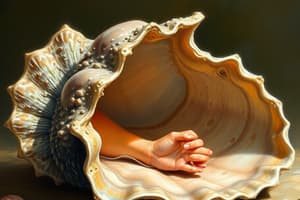Podcast
Questions and Answers
What are the characteristics of Class Bivalvia?
What are the characteristics of Class Bivalvia?
- Shell typically of one valve
- Shell typically of two hinged valves (correct)
- Foot is not compressed
- Presence of radula
Do Bivalvia have radula?
Do Bivalvia have radula?
False (B)
How are the shell valves closed?
How are the shell valves closed?
adductor muscles
What is the foot of Bivalvia adapted for?
What is the foot of Bivalvia adapted for?
What does a rudimentary head mean?
What does a rudimentary head mean?
What is a siphon?
What is a siphon?
What is the function of the palp?
What is the function of the palp?
What happens to particles after they enter the incurrent siphon?
What happens to particles after they enter the incurrent siphon?
What is a Bivalve Bauplan?
What is a Bivalve Bauplan?
What modifications occur in the Bivalve foot during burrowing?
What modifications occur in the Bivalve foot during burrowing?
What type of feeders are most Bivalves?
What type of feeders are most Bivalves?
Other than filter feeding, what are some feeding methods of Bivalves?
Other than filter feeding, what are some feeding methods of Bivalves?
Scallops and other clams can ___ to escape predators.
Scallops and other clams can ___ to escape predators.
Describe the process of Bivalve feeding and digestion.
Describe the process of Bivalve feeding and digestion.
What is the function of the crystalline style in the Bivalve stomach?
What is the function of the crystalline style in the Bivalve stomach?
What does the style sac keep producing?
What does the style sac keep producing?
What is required for Bivalve reproduction?
What is required for Bivalve reproduction?
What is a trocophore larva?
What is a trocophore larva?
What is a veliger larva?
What is a veliger larva?
What occurs during Bivalve reproduction?
What occurs during Bivalve reproduction?
How are pearls formed?
How are pearls formed?
What are shell shape and shell sculpture used for?
What are shell shape and shell sculpture used for?
What are different types of shell shapes?
What are different types of shell shapes?
What are different types of shell sculpture?
What are different types of shell sculpture?
What is Subclass Heterodonta?
What is Subclass Heterodonta?
What is Subclass Protobranchia?
What is Subclass Protobranchia?
Why are Bivalves important?
Why are Bivalves important?
How are Bivalves ecologically important?
How are Bivalves ecologically important?
What is the ecological role of oysters?
What is the ecological role of oysters?
Which clams are invasive and cause economic problems?
Which clams are invasive and cause economic problems?
What is a potential environmental impact of zebra mussels?
What is a potential environmental impact of zebra mussels?
Flashcards are hidden until you start studying
Study Notes
Class Bivalvia Characteristics
- Bivalves possess a shell made of two hinged valves that close using adductor muscles.
- They have a rudimentary head and lack a radula.
- The foot is laterally compressed, enabling penetration into substrates.
- Notable features include a pair of large bipectinate gills and a pair of nephridia.
- The posterior edges of the mantle can form siphons.
Feeding Mechanism
- Food capture begins when particles enter the incurrent siphon and travel to the gills.
- Gills use cilia to collect particles, guiding them to the mouth area, then to the stomach, intestines, and out via the excurrent siphon.
- Bivalves are primarily filter feeders, but some species exhibit alternative feeding strategies, including boring, detritivory, carnivory, and symbiotic relationships with bacteria or zooxanthellae.
Reproductive Strategies
- Bivalve reproduction typically involves separate sexes.
- Notable larval stages include the trochophore stage and the veliger stage, where shell formation begins.
- Reproduction events often involve mass release of eggs into the water.
Shell Characteristics
- Shell shape varies, with forms including irregular, elliptical, wedge-shaped, fan-shaped, and more, which are used for taxonomic identification.
- Shell sculpture varies with features such as nodular radial ribs and smooth surfaces, also utilized for classification.
Subclassifications
- Subclass Heterodonta is the largest group of bivalves and is mainly marine.
- Subclass Protobranchia consists mostly of deep-sea bivalves.
Ecological Roles
- Bivalves are significant food sources (e.g., oysters, clams, scallops) and play a crucial role in aquatic ecosystems by filter-feeding, which helps clean water.
- Oysters provide habitat structures, promoting biodiversity.
Invasive Species
- Zebra and brown mussels are invasive bivalve species known to cause economic damage.
- Zebra mussels can over-filter water, depleting plankton populations in certain regions.
Unique Features
- Pearls form as foreign bodies are encysted within layers of shell material.
- Bivalves possess a crystalline style in their stomach, which aids in digestion through mechanical and enzymatic processes.
Studying That Suits You
Use AI to generate personalized quizzes and flashcards to suit your learning preferences.




